Preparation and Characterization of Natural Silk Fibroin Hydrogel for Protein Drug Delivery
Abstract
:1. Introduction
2. Results and Discussion
2.1. Preparation and Characterization of Silk Fibroin
2.2. Micromorphology Analysis of Silk Fibroin Sol-Gel Transformations
2.3. Mechanical Properties of Silk Fibroin Hydrogels
2.4. Cytotoxicity Evaluation of Silk Fibroin Hydrogels
2.5. Degradation Behavior Evaluation of Silk Fibroin Hydrogels
2.6. Drug Loading and Release Properties of Silk Fibroin Hydrogels
3. Materials and Methods
3.1. Materials
3.2. Testing and Characterization
3.3. Experimental Methods
3.3.1. Micromorphology Analysis
3.3.2. Rheological Analysis
3.3.3. Cytotoxicity Assay
3.3.4. Degradation in Different Media
3.3.5. Drug Loading and Release
4. Conclusions
Supplementary Materials
Author Contributions
Funding
Institutional Review Board Statement
Informed Consent Statement
Data Availability Statement
Acknowledgments
Conflicts of Interest
Sample Availability
References
- Lamoolphak, W.; De-Eknamkul, W.; Shotipruk, A. Hydrothermal production and characterization of protein and amino acids from silk waste. Bioresour. Technol. 2008, 99, 7678–7685. [Google Scholar] [CrossRef] [PubMed]
- Liu, H.; Wei, J.; Zheng, L.J.; Zhao, Y.P. Extraction and characterization of silk fibroin from waste silk. Adv. Mater. Res. 2013, 788, 174–177. [Google Scholar] [CrossRef]
- Zamani, B.; Svanström, M.; Peters, G.; Rydberg, T. A carbon footprint of textile recycling: A case study in sweden. J. Ind. Ecol. 2015, 19, 676–687. [Google Scholar] [CrossRef]
- Tian, Y.; Jiang, X.J.; Chen, X.; Shao, Z.Z.; Yang, W.L. Doxorubicin-loaded magnetic silk fibroin nanoparticles for targeted therapy of multidrug-resistant cancer. Adv. Mater. 2014, 26, 7393–7398. [Google Scholar] [CrossRef]
- Luo, K.Y.; Yang, Y.H.; Shao, Z.Z. Physically crosslinked biocompatible silk-fibroin-based hydrogels with high mechanical performance. Adv. Funct. Mater. 2016, 26, 872–880. [Google Scholar] [CrossRef]
- Elliott, W.H.; Bonani, W.; Maniglio, D.; Motta, A.; Tan, W.; Migliaresi, C. Silk hydrogels of tunable structure and viscoelastic properties using different chronological orders of genipin and physical cross-linking. ACS Appl. Mater. Interfaces 2015, 7, 12099–12108. [Google Scholar] [CrossRef] [Green Version]
- Ghalei, S.; Handa, H. A review on antibacterial silk fibroin-based biomaterials: Current state and prospects. Mater. Today Chem. 2022, 23, 100673. [Google Scholar] [CrossRef]
- Nogueira, G.M.; Rodas, A.C.D.; Leite, C.A.P.; Giles, C.; Higa, O.Z.; Polakiewicz, B.; Beppu, M.M. Preparation and characterization of ethanol-treated silk fibroin dense membranes for biomaterials application using waste silk fibers as raw material. Bioresour. Technol. 2010, 101, 8446–8451. [Google Scholar] [CrossRef]
- Zheng, H.Y.; Zuo, B.Q. Functional silk fibroin hydrogels: Preparation, properties and applications. J. Mater. Chem. B 2021, 9, 1238–1258. [Google Scholar] [CrossRef]
- Jiang, M.R.; Shu, T.; Ye, C.; Ren, J.; Ling, S.J. Predicting the conformations of the silk protein through deep learning. Analyst 2021, 146, 2490–2498. [Google Scholar] [CrossRef]
- Dorishetty, P.; Dutta, N.K.; Choudhury, N.R. Silk fibroins in multiscale dimensions for diverse applications. RSC Adv. 2020, 10, 33227–33247. [Google Scholar] [CrossRef]
- Zhang, X.; Jiang, S.T.; Yan, T.F.; Fan, X.T.; Li, F.; Yang, X.D.; Ren, B.; Xu, J.Y.; Liu, J.Q. Injectable and fast self-healing protein hydrogels. Soft Matter 2019, 15, 7583–7589. [Google Scholar] [CrossRef]
- Tomeh, M.A.; Hadianamrei, R.; Zhao, X.B. Silk fibroin as a functional biomaterial for drug and gene delivery. Pharmaceutics 2019, 11, 494. [Google Scholar] [CrossRef] [PubMed] [Green Version]
- Yucel, T.; Lovett, M.L.; Kaplan, D.L. Silk-based biomaterials for sustained drug delivery. J. Control. Release 2014, 190, 381–397. [Google Scholar] [CrossRef] [PubMed] [Green Version]
- Hofmann, S.; Stok, K.S.; Kohler, T.; Meinel, A.J.; Müller, R. Effect of sterilization on structural and material properties of 3-D silk fibroin scaffolds. Acta Biomater. 2014, 10, 308–317. [Google Scholar] [CrossRef] [PubMed]
- Vepari, C.; Kaplan, D.L. Silk as a biomaterial. Prog. Polym. Sci. 2007, 32, 991–1007. [Google Scholar] [CrossRef]
- Tan, H.P.; Marra, K.G. Injectable, biodegradable hydrogels for tissue engineering applications. Materials 2010, 3, 1746–1767. [Google Scholar] [CrossRef]
- Kim, H.J.; Um, I.C. Effect of degumming ratio on wet spinning and post drawing performance of regenerated silk. Int. J. Biol. Macromol. 2014, 67, 387–393. [Google Scholar] [CrossRef]
- Chen, Z.Y.; Wang, Y.; Zhao, Y.J. Bioinspired conductive cellulose liquid-crystal hydrogels as multifunctional electrical skins. Proc. Natl. Acad. Sci. USA 2020, 117, 18310–18316. [Google Scholar]
- Wang, C.Y.; Xia, K.L.; Wang, H.M.; Liang, X.P.; Yin, Z.; Zhang, Y.Y. Advanced carbon for flexible and wearable electronics. Adv. Mater. 2019, 31, 1801072. [Google Scholar] [CrossRef]
- Ye, J.J.; Chu, T.S.; Chu, J.L.; Gao, B.B.; He, B.F. A versatile approach for enzyme immobilization using chemically modified 3D-printed scaffolds. ACS Sustain. Chem. Eng. 2019, 7, 18048–18054. [Google Scholar] [CrossRef]
- Song, W.T.; Das, M.; Xu, Y.D.; Si, X.H.; Zhang, Y.; Tang, Z.H.; Chen, X.S. Leveraging biomaterials for cancer immunotherapy: Targeting pattern recognition receptors. Mater. Today Nano 2019, 5, 100029. [Google Scholar] [CrossRef]
- Li, G.F.; Sun, S. Silk fibroin-based biomaterials for tissue engineering applications. Molecules 2022, 27, 2757. [Google Scholar] [CrossRef] [PubMed]
- Kim, M.H.; Park, W.H. Chemically cross-linked silk fibroin hydrogel with enhanced elastic properties, biodegradability, and biocompatibility. Int. J. Nanomed. 2016, 11, 2967–2978. [Google Scholar]
- Cheng, B.C.; Lei, Z.Y.; Wu, P.Y. Bio-derived crystalline silk nanosheets for versatile macroscopic assemblies. Nano Res. 2022. [Google Scholar] [CrossRef]
- Nagarkar, S.; Patil, A.; Lele, A.; Bhat, S.; Bellare, J.; Mashelkar, R.A. Some mechanistic insights into the gelation of regenerated silk fibroin sol. Ind. Eng. Chem. Res. 2009, 48, 8014–8023. [Google Scholar] [CrossRef]
- Jia, Y.G.; Zhu, X.X. Self-healing supramolecular hydrogel made of polymers bearing cholic acid and beta-cyclodextrin pendants. Chem. Mater. 2015, 27, 387–393. [Google Scholar] [CrossRef]
- Nagarkar, S.; Nicolai, T.; Chassenieux, C.; Lele, A. Structure and gelation mechanism of silk hydrogels. Phys. Chem. Chem. Phys. 2010, 12, 3834–3844. [Google Scholar] [CrossRef]
- Su, D.H.; Jiang, L.B.; Chen, X.; Dong, J.; Shao, Z.Z. Enhancing the gelation and bioactivity of injectable silk fibroin hydrogel with laponite nanoplatelets. ACS Appl. Mater. Interfaces 2016, 8, 9619–9628. [Google Scholar] [CrossRef]
- Kapoor, S.; Kundu, S.C. Silk protein-based hydrogels: Promising advanced materials for biomedical applications. Acta Biomater. 2016, 31, 17–32. [Google Scholar] [CrossRef]
- Hu, H.; Xu, F.J. Rational design and latest advances of polysaccharide-based hydrogels for wound healing. Biomater. Sci. 2020, 8, 2084–2101. [Google Scholar] [CrossRef] [PubMed]
- Wang, Z.J.; Hu, W.K.; Du, Y.Y.; Xiao, Y.; Wang, X.H.; Zhang, S.M.; Wang, J.L.; Mao, C.B. Green gas-mediated cross-linking generates biomolecular hydrogels with enhanced strength and excellent hemostasis for wound healing. ACS Appl. Mater. Interfaces 2020, 12, 13622–13633. [Google Scholar] [CrossRef] [PubMed]
- Hoffman, A.S. Hydrogels for biomedical applications. Adv. Drug Deliver. Rev. 2012, 64, 18–23. [Google Scholar] [CrossRef]
- Lu, Q.; Zhang, B.; Li, M.Z.; Zuo, B.Q.; Kaplan, D.L.; Huang, Y.L.; Zhu, H.S. Degradation mechanism and control of silk fibroin. Biomacromolecules 2011, 12, 1080–1086. [Google Scholar] [CrossRef] [Green Version]
- Fan, H.L.; Gong, J.P. Fabrication of bioinspired Hydrogels: Challenges and opportunities. Macromolecules 2020, 53, 2769–2782. [Google Scholar] [CrossRef]
- Murphy, A.R.; Kaplan, D.L. Biomedical applications of chemically-modified silk fibroin. J. Mater. Chem. 2009, 19, 6443–6450. [Google Scholar] [CrossRef] [Green Version]
- Numata, K.; Ifuku, N.; Masunaga, H.; Hikima, T.; Sakai, T. Silk resin with hydrated dual chemical-physical cross-links achieves high strength and toughness. Biomacromolecules 2017, 18, 1937–1946. [Google Scholar] [CrossRef] [Green Version]
- Wang, Z.Q.; Yang, H.W.; Zhu, Z. Study on the blends of silk fibroin and sodium alginate: Hydrogen bond formation, structure and properties. Polymer 2019, 163, 144–153. [Google Scholar] [CrossRef]
- Narita, C.; Okahisa, Y.; Yamada, K. A novel technique in the preparation of environmentally friendly cellulose nanofiber/silk fibroin fiber composite films with improved thermal and mechanical properties. J. Clean. Prod. 2019, 234, 200–207. [Google Scholar] [CrossRef]
- Liu, J.W.; Ding, Z.Z.; Lu, G.Z.; Wang, J.G.; Wang, L.; Lu, Q. Amorphous silk fibroin nanofiber hydrogels with enhanced mechanical properties. Macromol. Biosci. 2019, 19, 1900326. [Google Scholar] [CrossRef]
- Cui, Y.J.; Zhang, F.; Chen, G.; Yao, L.; Zhang, N.; Liu, Z.Y.; Li, Q.S.; Zhang, F.L.; Cui, Z.Q.; Zhang, K.Q.; et al. A stretchable and transparent electrode based on PEGylated silk fibroin for in vivo dual-modal neural-vascular activity probing. Adv. Mater. 2021, 33, 2100221. [Google Scholar] [CrossRef] [PubMed]
- Wang, X.Q.; Partlow, B.; Liu, J.; Zheng, Z.Z.; Su, B.; Wang, Y.S.; Kaplan, D.L. Injectable silk-polyethylene glycol hydrogels. Acta Biomater. 2015, 12, 51–61. [Google Scholar] [CrossRef] [PubMed]
- Xu, Z.P.; Chen, T.Y.; Zhang, K.Q.; Meng, K.; Zhao, H.J. Silk fibroin/chitosan hydrogel with antibacterial, hemostatic and sustained drug-release activities. Polym. Int. 2021, 70, 1741–1751. [Google Scholar] [CrossRef]
- Zhang, W.; Chen, J.L.; Qu, M.L.; Backman, L.J.; Zhang, A.N.; Liu, H.Y.; Zhang, X.P.; Zhou, Q.J.; Danielson, P. Sustained release of TPCA-1 from silk fibroin hydrogels preserves keratocyte phenotype and promotes corneal regeneration by inhibiting interleukin-1β signaling. Adv. Healthc. Mater. 2020, 9, 2000591. [Google Scholar] [CrossRef]
- Wang, Y.Y.; Niu, C.Q.; Shi, J.; Yu, W.L.; Zhu, C.H.; Zhang, Q.; Mizuno, M. A carbodiimide cross-linked silk fibroin/sodium alginate composite hydrogel with tunable properties for sustained drug delivery. Macromol. Mater. Eng. 2021, 306, 2100470. [Google Scholar] [CrossRef]
- Dong, A.C.; Prestrelski, S.J.; Allison, S.D.; Carpenter, J.F. Infrared spectroscopic studies of lyophilization-and temperature-induced protein aggregation. J. Pharm. Sci. 1995, 84, 415–424. [Google Scholar] [CrossRef]
- Dong, Z.F.; Wang, Q.; Du, Y.M. Alginate/gelatin blend films and their properties for drug controlled release. J. Membr. Sci. 2006, 280, 37–44. [Google Scholar] [CrossRef]
- Panjapheree, K.; Kamonmattayakul, S.; Meesane, J. Biphasic scaffolds of silk fibroin film affixed to silk fibroin/chitosan sponge based on surgical design for cartilage defect in osteoarthritis. Mater. Des. 2018, 141, 323–332. [Google Scholar] [CrossRef]
- Qi, Y.; Wang, H.; Wei, K.; Yang, Y.; Zheng, R.Y.; Kim, I.S.; Zhang, K.Q. A review of structure construction of silk fibroin biomaterials from single structures to multi-level structures. Int. J. Mol. Sci. 2017, 18, 237. [Google Scholar] [CrossRef]
- Lopes, L.M.; Moraes, M.A.; Beppu, M.M. Phase diagram and estimation of flory-huggins parameter of interaction of silk fibroin/sodium alginate blends. Front. Bioeng. Biotech. 2020, 8, 2296–2385. [Google Scholar] [CrossRef]
- Devi, D.; Sarma, N.S.; Talukdar, B.; Chetri, P.; Baruah, K.C.; Dass, N.N. Study of the structure of degummed Antheraea assamensis (muga) silk fibre. J. Text. Inst. 2011, 102, 527–533. [Google Scholar] [CrossRef]
- Ming, J.F.; Li, M.M.; Han, Y.H.; Chen, Y.; Li, H.; Zuo, B.Q.; Pan, F.K. Novel two-step method to form silk fibroin fibrous hydrogel. Mat. Sci. Eng. C-Mater. 2016, 59, 185–192. [Google Scholar] [CrossRef] [PubMed]
- Barud, H.G.O.; Barud, H.S.; Cavicchioli, M. Preparation and characterization of a bacterial cellulose/silk fibroin sponge scaffold for tissue regeneration. Carbohyd. Polym. 2015, 128, 41–51. [Google Scholar] [CrossRef] [PubMed] [Green Version]
- Samal, S.K.; Dash, M.; Chiellini, F.; Wang, X.Q.; Chiellini, E.; Declercq, H.A.; Kaplan, D.L. Silk/chitosan biohybrid hydrogels and scaffolds via green technology. RSC Adv. 2014, 4, 53547–53556. [Google Scholar] [CrossRef]
- Nogueira, G.M.; Weska, R.F.; Vieira, W.C.; Polakiewicz, B.; Rodas, A.C.D.; Higa, O.Z.; Beppu, M.M. A new method to prepare porous silk fibroin membranes suitable for tissue scaffolding applications. J. Appl. Polym. Sci. 2009, 114, 617–623. [Google Scholar] [CrossRef]
- Yucel, T.; Cebe, P.; Kaplan, D.L. Vortex-induced injectable silk fibroin hydrogels. Biophys. J. 2009, 97, 2044–2050. [Google Scholar] [CrossRef] [Green Version]
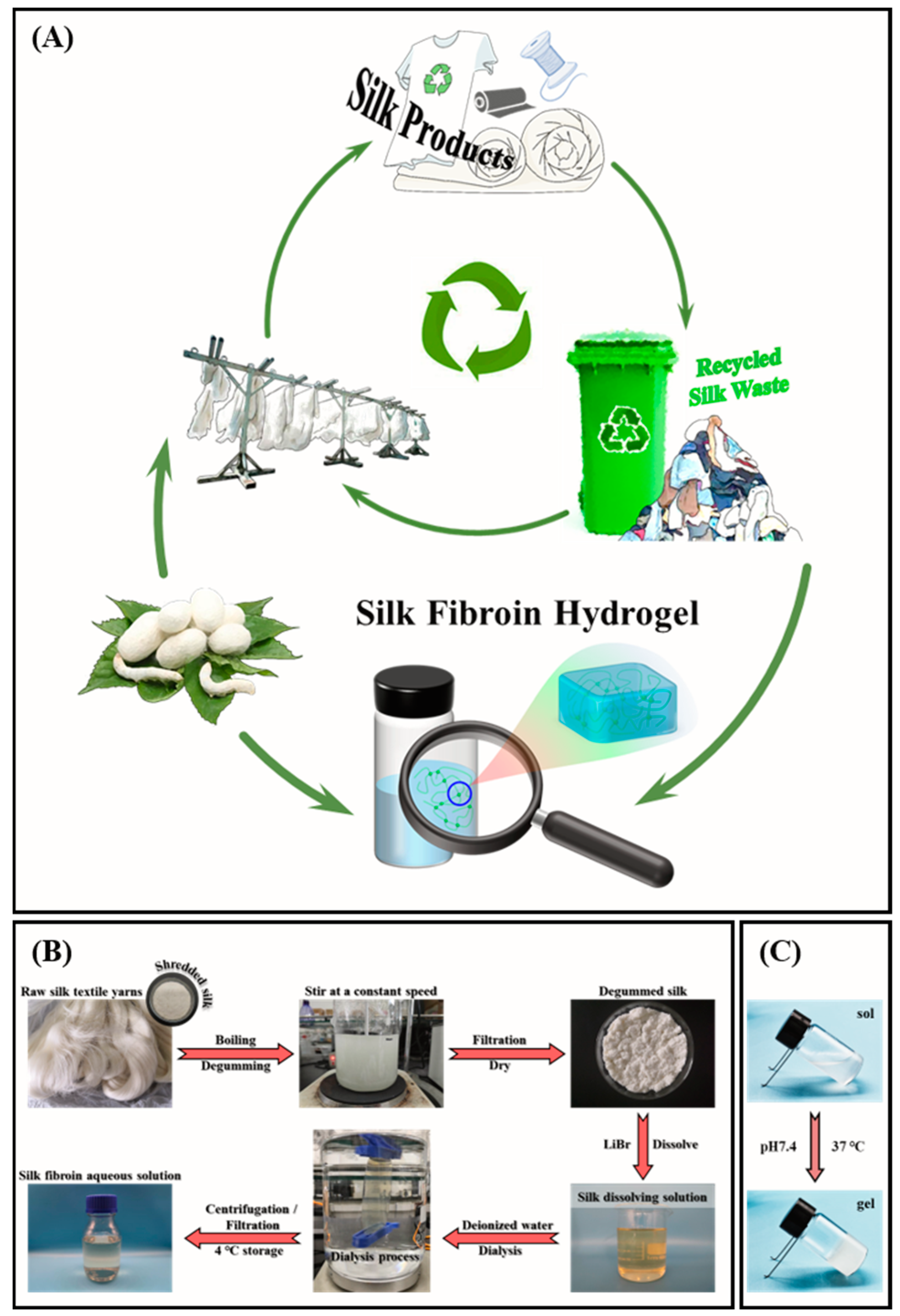
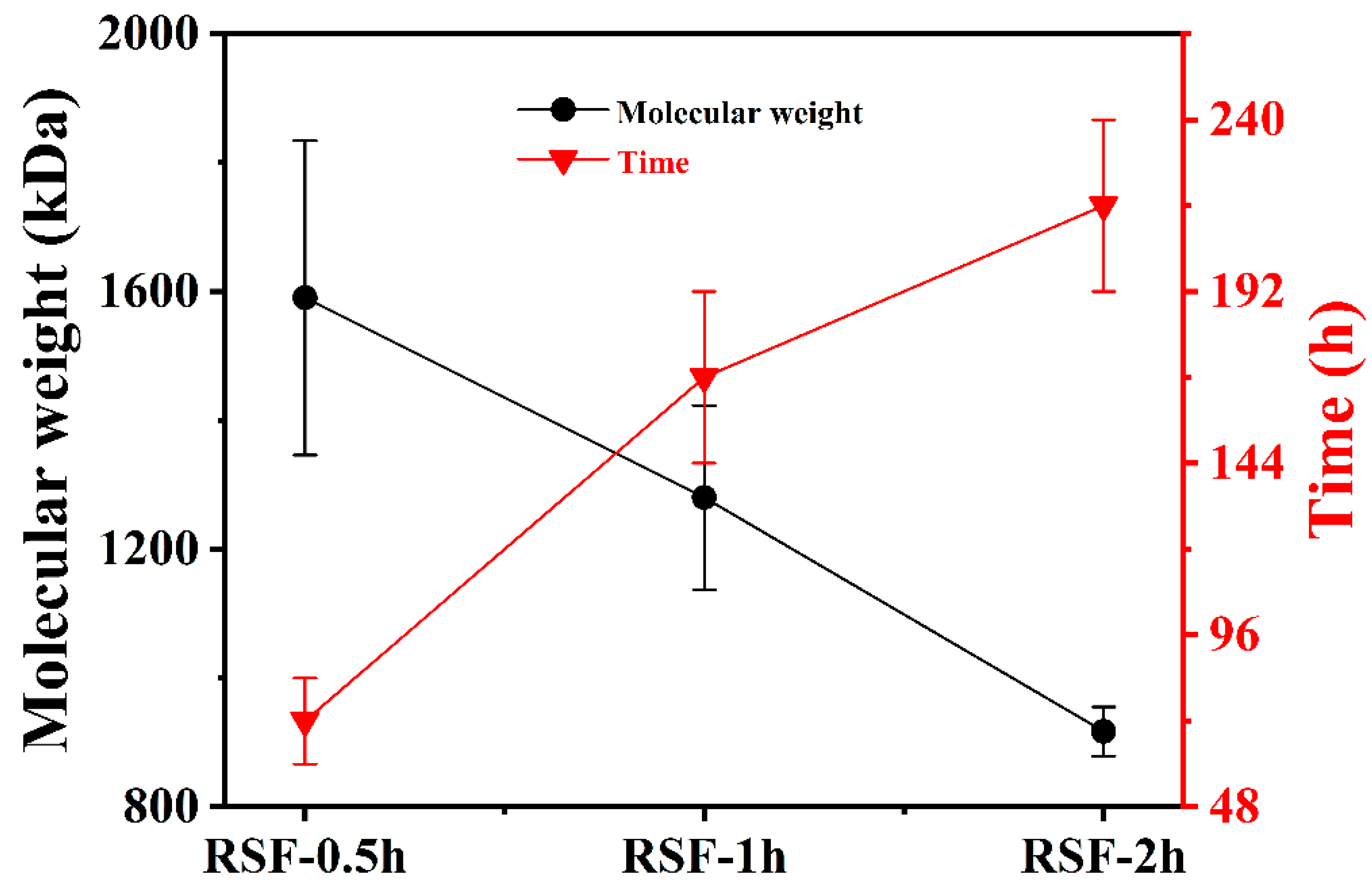
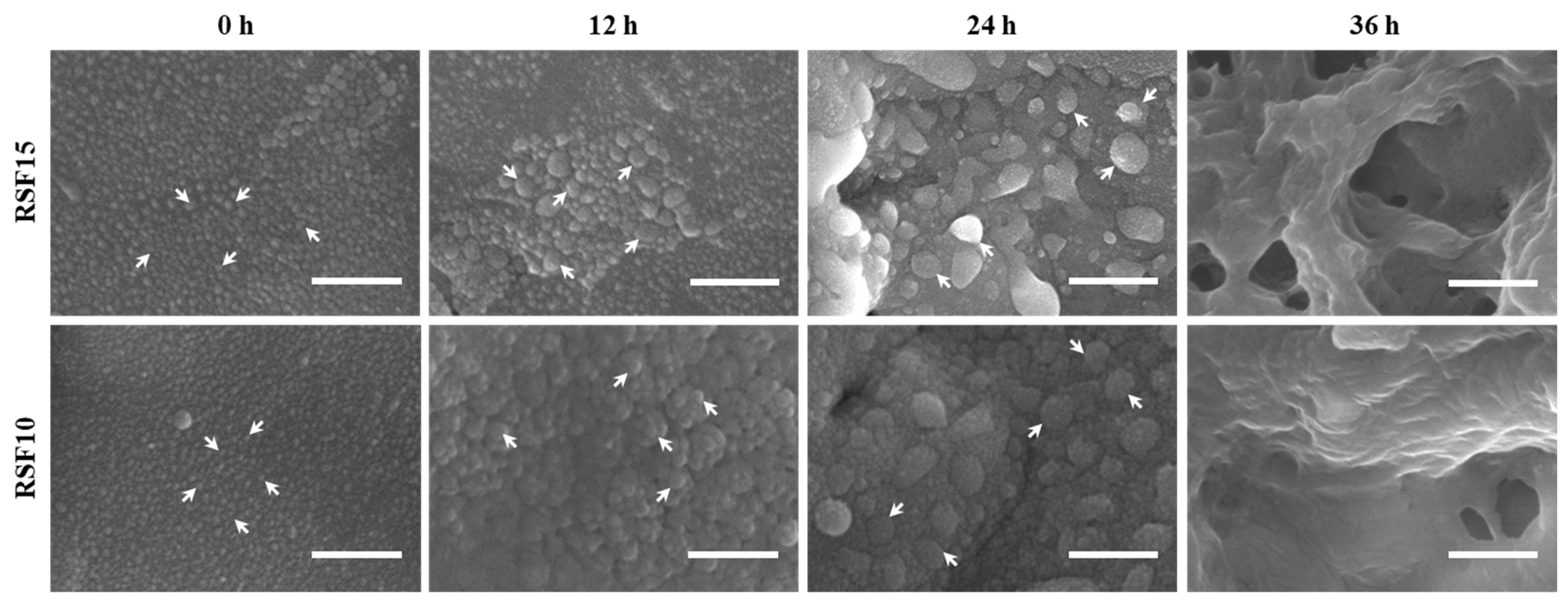

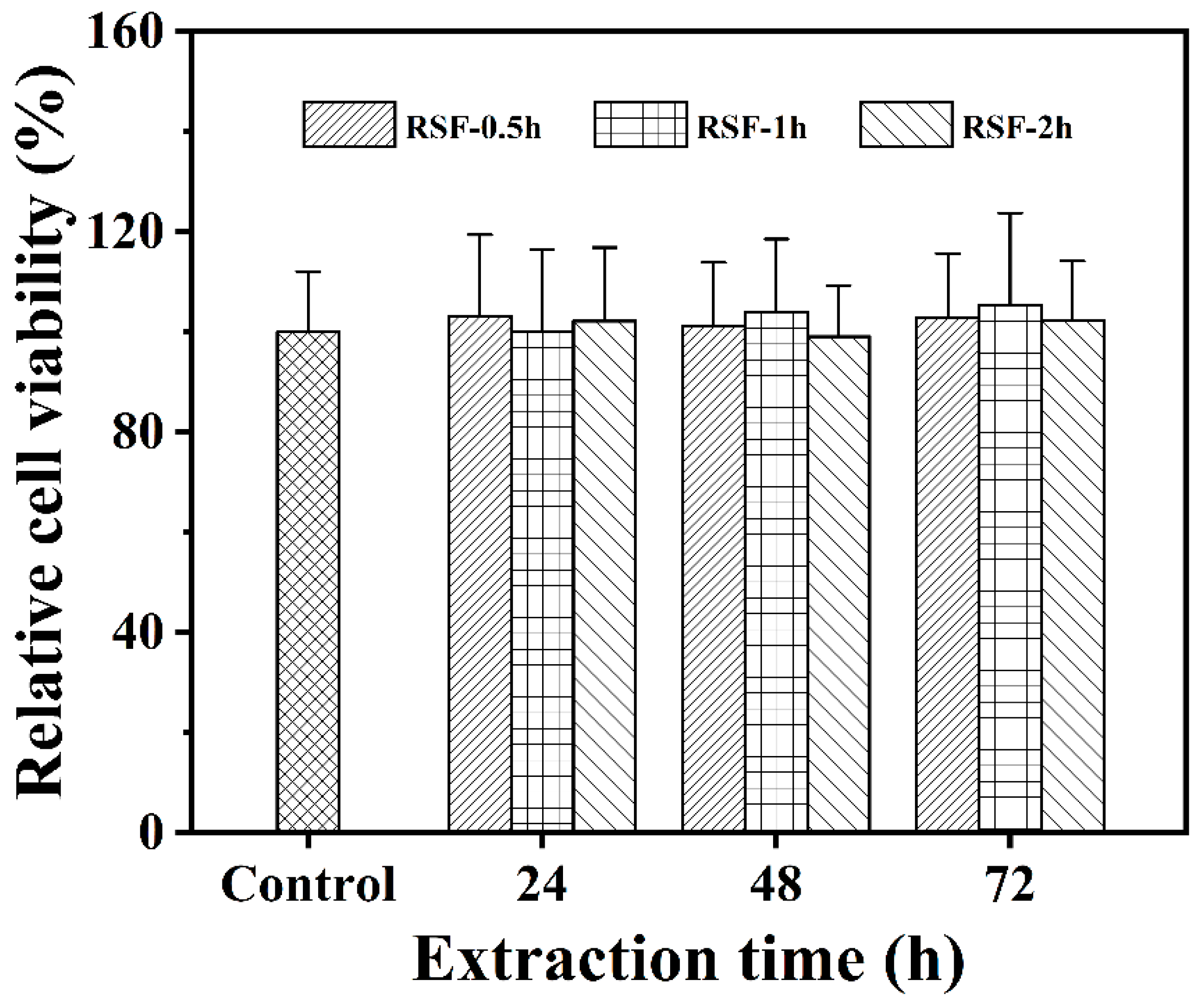
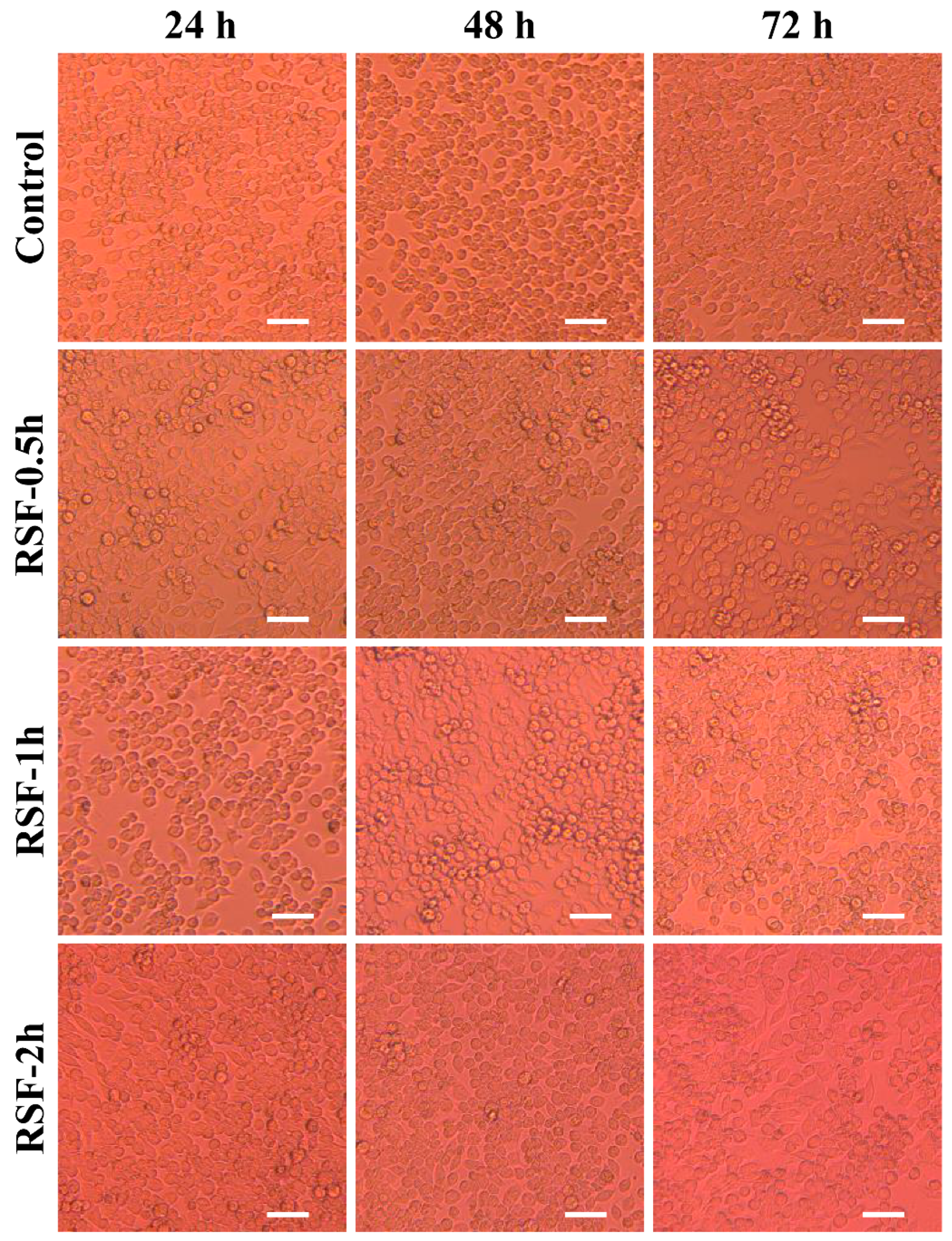
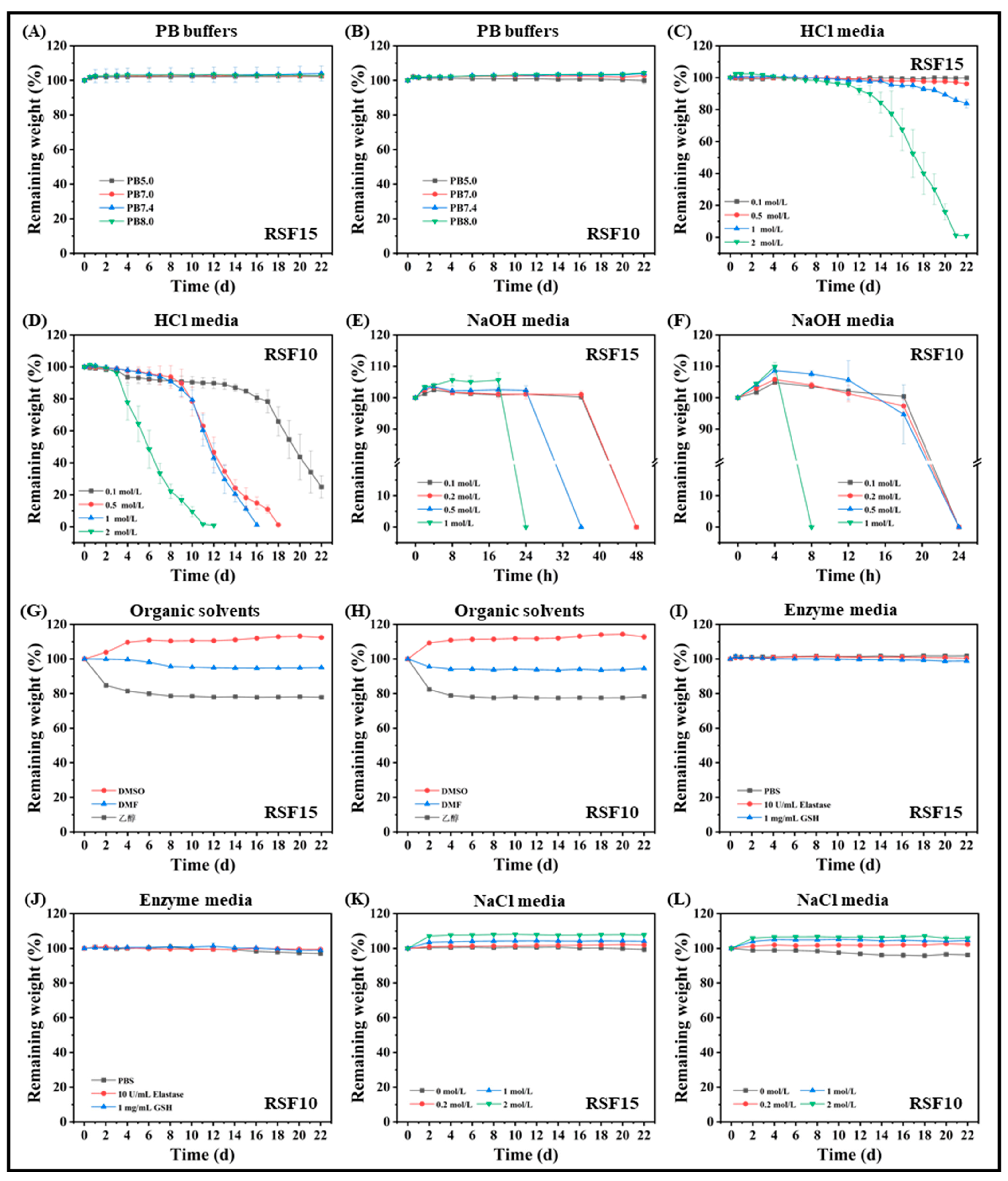
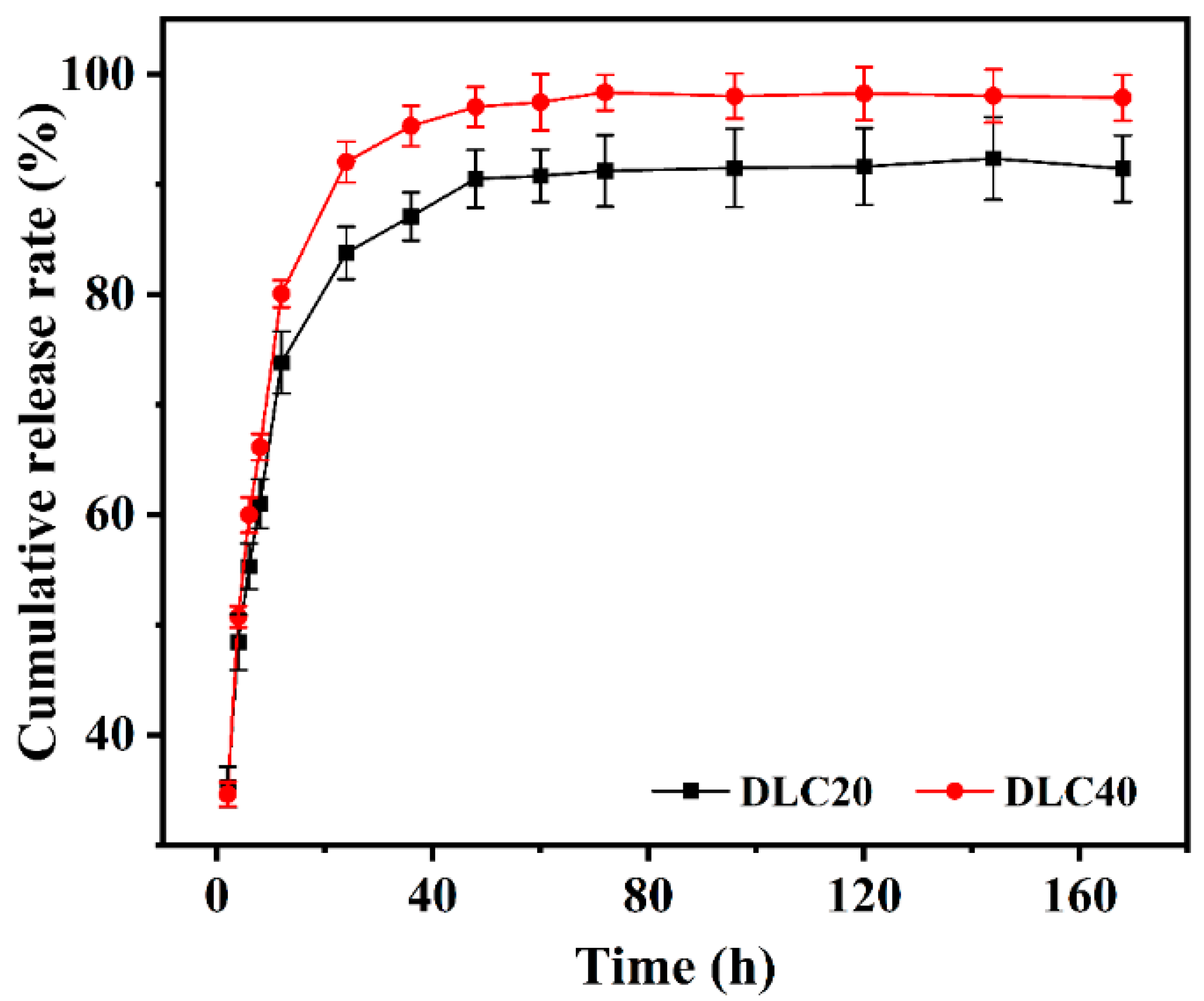
| Concentration/(mg/mL) | pH | Temperature/°C | ||||
|---|---|---|---|---|---|---|
| 4 | 20 | 30 | 40 | 50 | ||
| 15 | 5.0 | - | ++++ | +++ | +++ | ++ |
| 6.0 | - | ++++ | ++++ | +++ | +++ | |
| 7.0 | - | +++ | +++ | ++ | ++ | |
| 7.4 | - | +++ | ++ | ++ | + | |
| 8.0 | - | ++ | ++ | ++ | + | |
| 10 | 5.0 | - | ++++ | +++ | +++ | ++ |
| 6.0 | - | ++++ | ++++ | +++ | +++ | |
| 7.0 | - | +++ | +++ | +++ | ++ | |
| 7.4 | - | +++ | ++ | ++ | + | |
| 8.0 | - | ++ | ++ | ++ | + | |
| 5 | 5.0 | - | - | - | - | - |
| 6.0 | - | - | - | - | - | |
| 7.0 | - | - | - | - | - | |
| 7.4 | - | - | - | - | - | |
| 8.0 | - | - | - | - | - | |
Publisher’s Note: MDPI stays neutral with regard to jurisdictional claims in published maps and institutional affiliations. |
© 2022 by the authors. Licensee MDPI, Basel, Switzerland. This article is an open access article distributed under the terms and conditions of the Creative Commons Attribution (CC BY) license (https://creativecommons.org/licenses/by/4.0/).
Share and Cite
Liu, J.; Sun, H.; Peng, Y.; Chen, L.; Xu, W.; Shao, R. Preparation and Characterization of Natural Silk Fibroin Hydrogel for Protein Drug Delivery. Molecules 2022, 27, 3418. https://doi.org/10.3390/molecules27113418
Liu J, Sun H, Peng Y, Chen L, Xu W, Shao R. Preparation and Characterization of Natural Silk Fibroin Hydrogel for Protein Drug Delivery. Molecules. 2022; 27(11):3418. https://doi.org/10.3390/molecules27113418
Chicago/Turabian StyleLiu, Junwei, Haowen Sun, Yuwei Peng, Ligen Chen, Wei Xu, and Rong Shao. 2022. "Preparation and Characterization of Natural Silk Fibroin Hydrogel for Protein Drug Delivery" Molecules 27, no. 11: 3418. https://doi.org/10.3390/molecules27113418
APA StyleLiu, J., Sun, H., Peng, Y., Chen, L., Xu, W., & Shao, R. (2022). Preparation and Characterization of Natural Silk Fibroin Hydrogel for Protein Drug Delivery. Molecules, 27(11), 3418. https://doi.org/10.3390/molecules27113418






